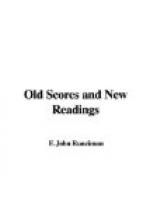“FIDELIO”
As an enthusiastic lover of “Fidelio” I may perhaps be permitted to put one or two questions to certain other of its lovers. Is it an opera at all?—does it not consist of one wonderfully touching situation, padded out before and behind,—before with some particularly fatuous reminiscences of the old comedy of intrigue, behind with some purely formal business and a pompous final chorus? “Fidelio” exists by reason of that one tremendous scene: there is nothing else dramatic in it: however fine the music is, one cannot forget that the libretto is fustian and superfluous nonsense. Had Beethoven possessed the slightest genius for opera, had he possessed anything like Mozart’s dramatic instinct (and of course his own determination to touch nothing but fitting subjects), he would have felt that no meaner story than the “Flying Dutchman” would serve as an opportunity to say all that was aroused in his heart and in his mind by the tale of Leonora. As he had no genius whatever for opera, no sense of the dramatic in life, the tale of Leonora seemed to him good enough; and, after all, in its essence it is the same as the tale of Senta. The Dutchman himself happens to be more interesting than Florestan because of his weird fate; but he is no more the principal character in Wagner’s opera than Florestan is the principal character in Beethoven’s opera. The principal character in each case is the woman who takes her fate into her own hands and fearlessly chances every risk for the sake of the man she loves. And just as Wagner wrote the best passage in the “Dutchman” for the moment when Senta promises to be faithful through life and death, so Beethoven in the prison scene of “Fidelio” wrote as tremendous a passage as even he ever conceived for the moment when Leonora makes up her mind at all costs to save the life of the wretched prisoner whose grave she is




